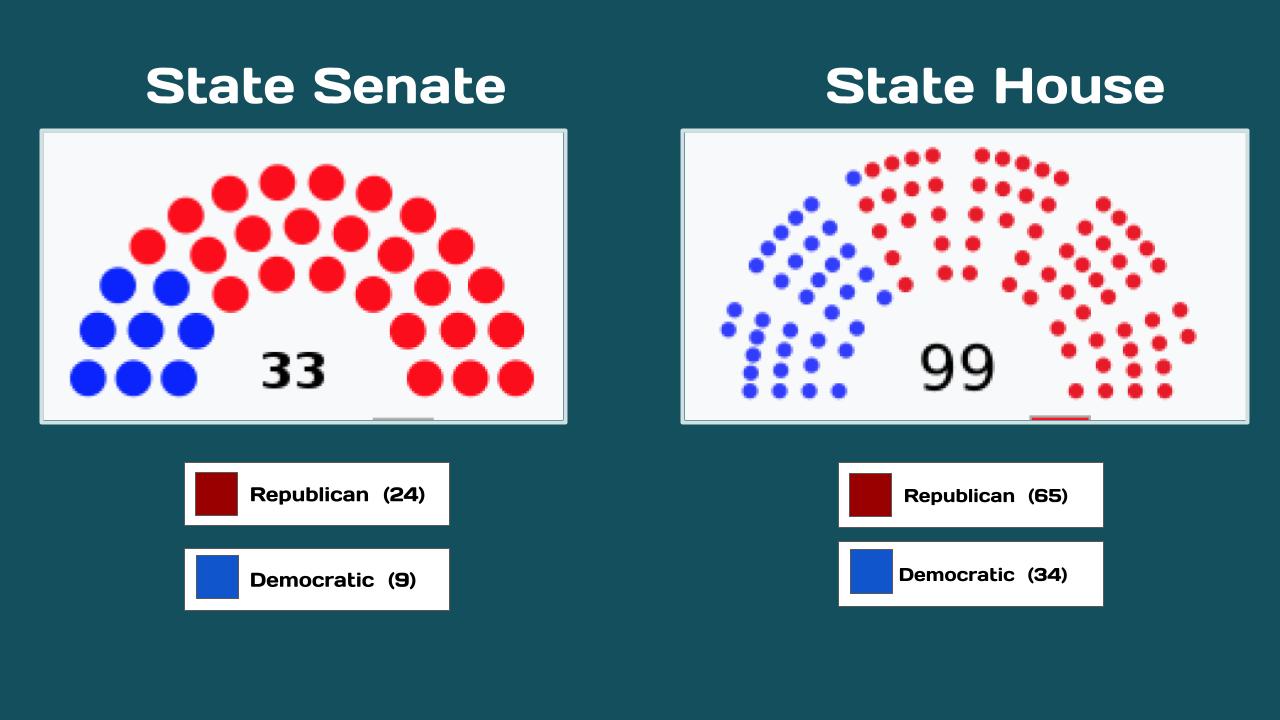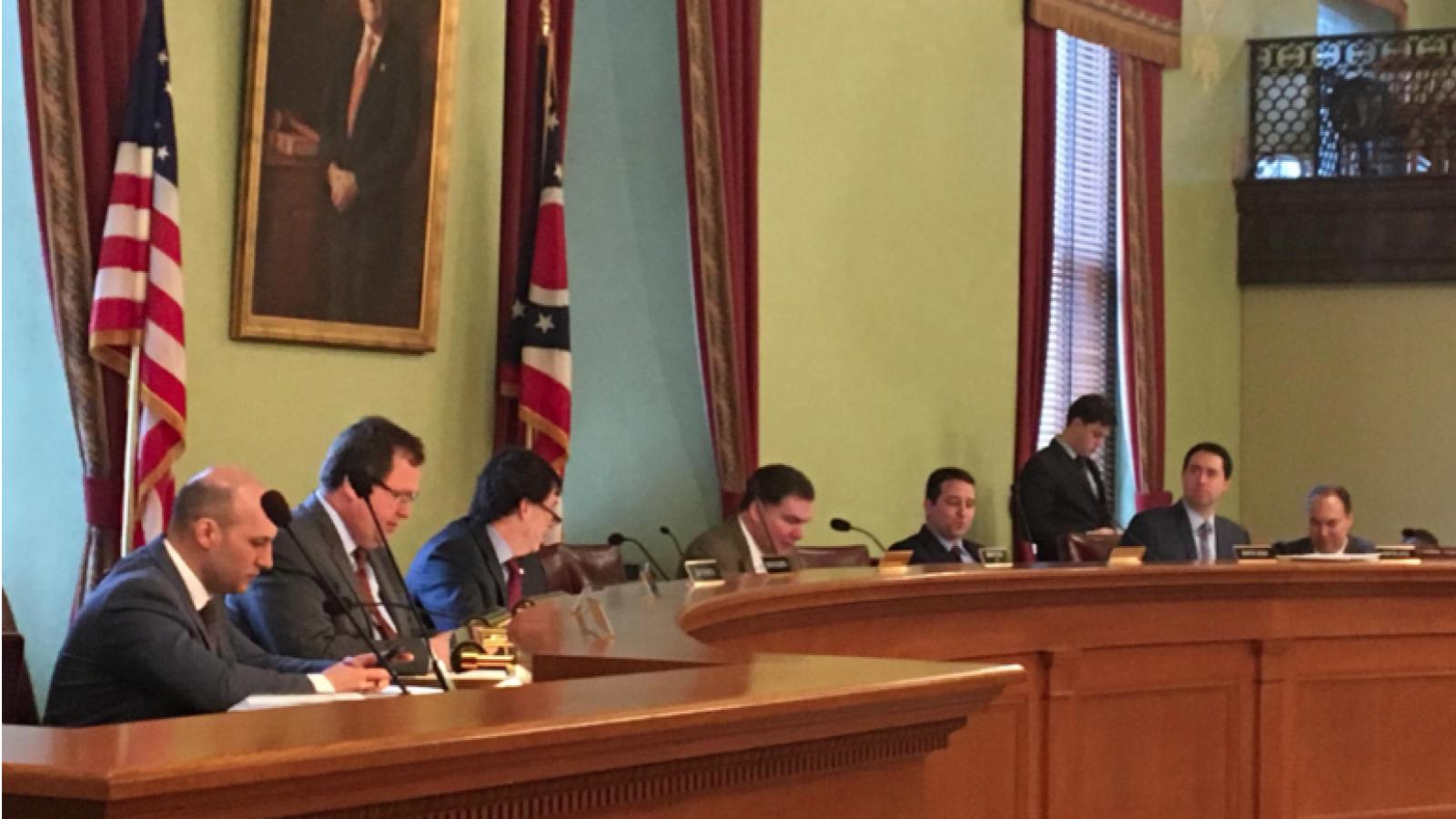Summary
News
A new version of a bill to allow personnel to be armed in schools has returned to the Ohio legislature, this time with slight changes that could give school districts more control.
House Bill 99 was quickly presented in Thursday’s Ohio House Criminal Justice Committee, only to have a few provisions in the bill changed before the end of the meeting.
It was initially written to create minimum training standards for teachers and school personnel to come armed on school property and to allow the practice in direct response to an Ohio Supreme Court case trying to fight against it.
It was the second iteration of the bill, which was introduced in the last General Assembly. That bill passed the Senate, but didn’t pass through the House before the GA’s end.
Groups ranging from the Fraternal Order of Police to the Ohio Federation of Teachers spent hours testifying against the legislation, saying the bill was not necessary, but that if it persisted, more training had to be included.
Supporters of the bill said in previous hearings that said more protection was always better, particularly in areas where emergency responders could take more time to get to schools because of their location. But they also said consistent training was an important part of school safety.
Ohio Capital Journal, – October 21, 2021
Ohio House lawmakers are running back a fight over trans youth in the state. But this time, instead of focusing on school sports, the proposal would prohibit offering minors any kind of gender affirming treatment — from hormones to surgery. The measure, H.B. 454, puts the onus on health care providers by defining that treatment as “unprofessional conduct” for state licensing boards, and making “actual or threatened violations” of the bill grounds for a lawsuit.
Erin Upchurch, executive director of Columbus’ Kaleidoscope Youth Center, calls the bill dehumanizing.
“I feel frustrated and angry and extremely disappointed that people who were voted into office to protect all Ohioans are using their platform and their power to actually attack a really specific portion of our communities,” she said. “It is a gross misuse of power and completely an overreach.”
The bill’s sponsors, Rep. Gary Click, R-Vickery, and Diane Grendell, R-Chesterland, begin by enumerating a series of legislative findings—a laundry list of dubious assertions meant to cast doubt on trans identities and the safety of medical procedures.
“The risks of gender transition procedures far outweigh any benefit at this stage of clinical study on these procedures,” the legislation claims.
Upchurch disputes that, noting national organizations like the American Academy of Pediatrics support gender affirming care.
Ohio Capital Journal, – September 30, 2021
A bill hinging on the downfall of federal abortion rights came into a Senate committee Wednesday with the support of its two Republican sponsors.
Senate Bill 123 is a “trigger” bill that would allow the state to ban abortion with a change in the U.S. Constitution or the overturning of the U.S. Supreme Court decision in Roe v. Wade.
The bill criminalizes a physician’s role in an abortion in the state, threatening prison time and the revocation of medical licenses for any doctor participating or promoting abortion. Bill cosponsor state Sen. Sandra O’Brien, R-Ashtabula, said the work against abortions doesn’t stop with just the challenges to Roe v. Wade.
“Overturning Roe v. Wade does not make abortion illegal,” O’Brien told the Senate Health Committee on Wednesday. “It simply changes the venue of this question from nine unelected Supreme Court justices to the people to enact abortion policy through their elected state legislators.”
Senate Health Committee member Sen. Cecil Thomas, D-Avondale, pushed back on the bill, arguing that calling Ohio a “pro-life state” as O’Brien did, was not supported by data.
“Survey after survey has concluded the majority of Ohioans believe abortions should be legal and that politicians should not be making personal decisions for them about their pregnancies,” Thomas said.
Ohio Capital Journal, – September 30, 2021
Ohio House Republicans have pumped the brakes on what was once turbo-charged legislation aimed to restrict abilities of employers and colleges to require vaccination against COVID-19.
The House Speaker and top lawmakers introduced the legislation Tuesday afternoon with the intent of the whole House passing it Wednesday. The House Health Committee passed it 11-3 on party lines Tuesday.
However, before a legislative session commenced Wednesday afternoon, the bill drew fierce criticism from the health care and business community, and even anti-vaccine activists who said it didn’t go far enough.
The Ohio Children’s Hospital Association, in a statement on behalf of a wide range of health care businesses and associations, said the bill falls short of what the state needs.
“This bill does not address the concerns expressed by the medical, business and university communities about prior proposals of a similar nature,” the statement says. “Protection of an employer’s rights to make decisions in the best interest of their employees and those we serve cannot be overstated.”
Steve Stivers, a former GOP congressman turned CEO of the Chamber of Commerce, said the bill infringes on the rights of employers.
Associated Press, – August 24, 2021
COLUMBUS, Ohio (AP) — Hundreds of supporters of a Republican-backed bill that would prohibit employers from requiring workers to receive vaccinations descended on the Ohio Statehouse on Tuesday as lawmakers heard a single additional day of testimony on the closely watched proposal.
While speakers before the GOP-controlled House Health Committee were evenly divided between those for and against the measure, supporters far outnumbered them on the Statehouse grounds.
Hundreds rallied outside ahead of time carrying signs with slogans such as “Enact Vaccine Choice” and “No To Forced Vaccines!”, then crowded into the Statehouse atrium to watch the hearing live on large-screen TVs, applauding speakers who favored the legislation and laughing at those who didn’t.
Just minutes after the committee wrapped up Tuesday, Ohio State University announced it would require all students, faculty and staff to complete the full vaccination process by Nov. 15. President Kristina Johnson pegged the decision to the Food and Drug Administration’s decision Monday to grant full approval to the Pfizer vaccine. Ohio State is one of the country’s largest universities and a major Columbus employer.
Ohio Capital Journal, – June 3, 2021
What some Ohio lawmakers saw as a wasteful gameshow gimmick, other governors saw as an opportunity.
It took only a few weeks after Gov. Mike DeWine announced the Vax-A-Million for other states to introduce their own vaccine lottery programs. There are cash prizes in Oregon, music festival tickets awarded in Delaware and even custom rifles available for the winners in West Virginia.
“I can’t stand for Ohio to get ahead of us on anything,” the Charleston Gazette-Mail quoted Gov. Jim Justice as saying.
There are nearly a dozen states across the country offering some type of vaccine lottery. In total, these states are offering close to $50 million in prize money along with college scholarships and other prizes.
About
Source: Wikipedia
Legislative agencies
The Legislative Service Commission is one of several legislative agencies. It serves as a source for legal expertise and staffing and drafts proposed legislation, also helps serve as an advertisement to the general public as to what is happening inside the assembly.
History
The General Assembly first convened in Chillicothe, then the Ohio capital, on March 1, 1803.[4]
The second constitution of Ohio, effective in 1851, took away the power of the General Assembly to choose the state’s executive officers, granting that right to the voters. A complicated formula apportioned legislators to Ohio counties and the number of seats in the legislative houses varied from year-to-year.[5]
The Ohio Politics Almanac by Michael F. Curtin (Kent State University Press) described apportionment thus:
The new [1851] constitution … contained a complicated formula for apportionment, the so-called “major fraction rule.” Under it, the state’s population was divided by 100, with the resulting quotient being the ratio of representation in the House of Representatives. Any county with a population equal to at least half the ratio was entitled to one representative; a county with a population of less than half the ratio was grouped with an adjacent county for districting; a county containing a population of at least one and three-fourths the ratio was entitled to two representatives; a county with a population equal to three times the ratio was entitled to three representatives. To determine Senate districts, a similar procedure was followed; the starting point, however was figured by dividing the state’s population by 35. The ratios for the House and Senate and the resulting apportionment was determined by a board consisting of the governor, auditor, and secretary of state.
In 1903, the apportionment system was modified by the Hanna amendment, which also gave the governor veto power over the assembly’s acts, which could be overridden by a two-thirds vote of both houses. The last state constitutional convention, held in 1912, gave the governor a line-item veto, but reduced the supermajority required for overriding the veto to three-fifths. In 1956, a referendum increased the terms of state senators from two to four years.
The Hanna amendment (which guaranteed each county at least one representative and all members elected at large) guaranteed that rural areas of Ohio would dominate the legislature. However, several decisions by the U.S. Supreme Court surrounding the legal principal of one man, one vote mandated apportionment proportional to population. Reapportionment was ordered in 1964. Starting with the 1966 election, the number of seats in the two chambers were fixed at their present numbers of 33 and 99.
Republican activists, led by Fred A. Lennon, began pursuing term limits in the 1980s, in 1992, a referendum set term limits of eight consecutive years in office: four consecutive terms in the House or two consecutive terms in the Senate. Years in office are considered consecutive if they are separated by less than four years. A former member of the legislature who had served eight years becomes eligible for election to the legislature after four years out of office.
Vacancies
The Ohio House and Ohio Senate use slightly different methods to fill vacant seats. In both chambers, a replacement is first elected by the members of the relevant chamber who are affiliated with the same party as the departing member. In the House, the replacement will serve for the remainder of the term. In the Senate, the replacement will serve for the remainder of the term only if the vacancy occurred after the first 20 months of the four-year Senate term. If the vacancy occurred during the first 20 months of the term, then a special election will be held during the next regularly-scheduled even-year statewide election. The replacement selected by the party members will then serve until the end of December following the special election, with the winner serving the remainder of the term.[6]
See also
- Representative history of the Ohio Senate
- Representative history of the Ohio House of Representatives
- List of Ohio state legislatures
References
- The Ohio General Assembly Official Government Website, https://www.legislature.ohio.gov/
- The Ohio House Official Government Website, http://www.ohiohouse.gov/index
- The Ohio Senate Official Government Website, http://ohiosenate.gov/
- Blue, Frederick J. (Autumn 2002). “The Date of Ohio Statehood”. Ohio Academy of History Newsletter. Archived from the original on September 11, 2010.
- A Brief History of Ohio’s State Government,https://www.legislature.ohio.gov/publications/a-brief-history
- “The Ohio Legislature”. www.legislature.ohio.gov. Retrieved December 6, 2020.
Further reading
- Curtin, Michael F. (1996). The Ohio Politics Almanac. Kent State University Press. ISBN 9780873385404.
- Gold, David M. (2009). Democracy In Session: A History of the Ohio General Assembly. Ohio University Press. ISBN 9780821418444.
- “A Guidebook For Ohio Legislators, 2013-2014” (PDF). Ohio Legislative Service Commission. Retrieved August 12, 2014.
- Little, Thomas H.; Ogle, David B., eds. (2006). The Legislative Branch of State Government: People, Process, and Politics. ABC-CLIO. pp. 369–373. ISBN 9781851097616.
the legislative branch of state government: people.
- Scarselli, Gino J.; Steinglass, Steven H. (2011). The Ohio State Constitution. Oxford University Press. ISBN 9780199778720.
External links
Wikipedia
Contents
The Ohio General Assembly is the state legislature of the U.S. state of Ohio. It consists of the 99-member Ohio House of Representatives and the 33-member Ohio Senate. Both houses of the General Assembly meet at the Ohio Statehouse in Columbus.[1][2][3]
Legislative agencies
The Legislative Service Commission is one of several legislative agencies. It serves as a source for legal expertise and staffing and drafts proposed legislation, also helps serve as an advertisement to the general public as to what is happening inside the assembly.
History
The General Assembly first convened in Chillicothe, then the Ohio capital, on March 1, 1803.[4]
The second constitution of Ohio, effective in 1851, took away the power of the General Assembly to choose the state’s executive officers, granting that right to the voters. A complicated formula apportioned legislators to Ohio counties and the number of seats in the legislative houses varied from year-to-year.[5]
The Ohio Politics Almanac by Michael F. Curtin (Kent State University Press) described apportionment thus:
The new [1851] constitution … contained a complicated formula for apportionment, the so-called “major fraction rule.” Under it, the state’s population was divided by 100, with the resulting quotient being the ratio of representation in the House of Representatives. Any county with a population equal to at least half the ratio was entitled to one representative; a county with a population of less than half the ratio was grouped with an adjacent county for districting; a county containing a population of at least one and three-fourths the ratio was entitled to two representatives; a county with a population equal to three times the ratio was entitled to three representatives. To determine Senate districts, a similar procedure was followed; the starting point, however was figured by dividing the state’s population by 35. The ratios for the House and Senate and the resulting apportionment was determined by a board consisting of the governor, auditor, and secretary of state.
In 1903, the apportionment system was modified by the Hanna amendment, which also gave the governor veto power over the assembly’s acts, which could be overridden by a two-thirds vote of both houses. The last state constitutional convention, held in 1912, gave the governor a line-item veto, but reduced the supermajority required for overriding the veto to three-fifths. In 1956, a referendum increased the terms of state senators from two to four years.
The Hanna amendment (which guaranteed each county at least one representative and all members elected at large) guaranteed that rural areas of Ohio would dominate the legislature. However, several decisions by the U.S. Supreme Court surrounding the legal principal of one man, one vote mandated apportionment proportional to population. Reapportionment was ordered in 1964. Starting with the 1966 election, the number of seats in the two chambers were fixed at their present numbers of 33 and 99.
Republican activists, led by Fred A. Lennon, began pursuing term limits in the 1980s, in 1992, a referendum set term limits of eight consecutive years in office: four consecutive terms in the House or two consecutive terms in the Senate. Years in office are considered consecutive if they are separated by less than four years. A former member of the legislature who had served eight years becomes eligible for election to the legislature after four years out of office.
Vacancies
The Ohio House and Ohio Senate use slightly different methods to fill vacant seats. In both chambers, a replacement is first elected by the members of the relevant chamber who are affiliated with the same party as the departing member. In the House, the replacement will serve for the remainder of the term. In the Senate, the replacement will serve for the remainder of the term only if the vacancy occurred after the first 20 months of the four-year Senate term. If the vacancy occurred during the first 20 months of the term, then a special election will be held during the next regularly-scheduled even-year statewide election. The replacement selected by the party members will then serve until the end of December following the special election, with the winner serving the remainder of the term.[6]
See also
- Representative history of the Ohio Senate
- Representative history of the Ohio House of Representatives
- List of Ohio state legislatures
References
- ^ The Ohio General Assembly Official Government Website, https://www.legislature.ohio.gov/
- ^ The Ohio House Official Government Website, http://www.ohiohouse.gov/index
- ^ The Ohio Senate Official Government Website, http://ohiosenate.gov/
- ^ Blue, Frederick J. (Autumn 2002). “The Date of Ohio Statehood”. Ohio Academy of History Newsletter. Archived from the original on September 11, 2010.
- ^ A Brief History of Ohio’s State Government, https://www.legislature.ohio.gov/publications/a-brief-history
- ^ “The Ohio Legislature”. www.legislature.ohio.gov. Retrieved December 6, 2020.
Further reading
- Curtin, Michael F. (1996). The Ohio Politics Almanac. Kent State University Press. ISBN 9780873385404.
- Gold, David M. (2009). Democracy In Session: A History of the Ohio General Assembly. Ohio University Press. ISBN 9780821418444.
- “A Guidebook For Ohio Legislators, 2013-2014” (PDF). Ohio Legislative Service Commission. Retrieved August 12, 2014.
- Little, Thomas H.; Ogle, David B., eds. (2006). The Legislative Branch of State Government: People, Process, and Politics. ABC-CLIO. pp. 369–373. ISBN 9781851097616.
the legislative branch of state government: people.
- Scarselli, Gino J.; Steinglass, Steven H. (2011). The Ohio State Constitution. Oxford University Press. ISBN 9780199778720.
External links
39°57′42″N 82°59′55″W / 39.9616°N 82.9987°W








